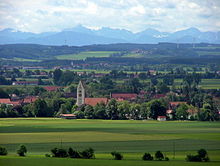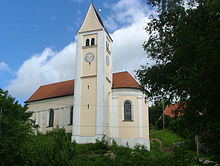Daxberg (Erkheim)
|
Daxberg
Erkheim market
Coordinates: 48 ° 3 ′ 32 ″ N , 10 ° 19 ′ 16 ″ E
|
|
|---|---|
| Height : | 650 m above sea level NHN |
| Incorporation : | July 1, 1972 |
| Postal code : | 87746 |
| Area code : | 08336 |
|
Village street
|
|
Daxberg is a church village in the Swabian district of Unterallgäu in Bavaria with about 300 inhabitants. The place lies between the cities of Memmingen and Mindelheim on the right bank of the Eastern Günz . Since its incorporation as part of the municipal reorganization of Bavaria on July 1, 1972, the village has been a district of the three kilometers south of Markt Erkheim .
history
The upper Günztal was settled in the 8th century BC. By the Celts . Barrows in the forest east of Daxberg are evidence of this. A coin find from the time of Emperor Trajan in a gravel pit between the village and the lost Altenberg Castle shows Roman influences at the beginning of the 2nd century. It is conceivable that the Roman road documented in the Peutinger plaque led between the settlements of Augusta Vindelicorum (Augsburg) and Viaca (presumably Memmingen ) through the area of what is now Daxberg. In the 9th century the place came under the feudal lordship of the Kempten monastery . The castle stables in Oberdaxberg, Mitteldaxberg and Unterdaxberg or Altenberg , which are still clearly visible today, were built between 950 and 1200 . In 972 a church was first mentioned in a document.
In the High Middle Ages , Friedrich and Manegold von Daxberg appeared among the ministerials of the Ottobeuren monastery, members of a local knight family . At the beginning of the 13th century, the Knights of Eisenburg held rights in Daxberg.
In 1362 the Knights of Königsegg were landlords in neighboring Erkheim. In 1390 they sold their fiefdom including Oberdaxberg Castle to the patrician Benz Huit from Memmingen. The Leutkircher family from Memmingen has been recorded at Mitteldaxberg Castle since 1352. Finally in 1402 the Memmingen citizen Gerung der Wilheymer acquired Niederdaxberg Castle , so that at the beginning of the 15th century practically the entire place was owned by three Memmingen patrician families.
In the first half of the 16th century, the Zwicker family bought the entire place. However, Georg Zwicker sold his property in Daxberg to Eustachius von Landfried in 1557 . In 1590 Hans Fugger bought the place from him for the amount of 21,000 guilders . Through a contract between the Bavarian Duke Maximilian of Bavaria and Maria Fugger , the lower court district of Daxberg came to Bavaria in 1617 under the rule of Mindelheim .
In the course of the reorganization of the Bavarian state system at the beginning of the 19th century, the Daxberg district first came to the Mindelheim district court . By ordinance of July 21, 1813, it was then incorporated into the Ottobeuren regional court . With the second community edict of May 17, 1818, the tax district of Daxberg formed the community of the same name with the district Moosmühle. Only in the course of the municipal reform of the 1970s did the place lose its political independence on July 1, 1972 and became a part of the municipality of Erkheim.
Attractions
The townscape is dominated by the tower of the Catholic branch church St. Nikolaus . The nave of the church, which originally dates from the Middle Ages, was probably built in the 17th century. In 1710 a choir was added.
In addition to the church, the following buildings and monuments are listed:
- A farmhouse with remains ( neck ditch ) of the former Oberdaxberg castle stables as well as the medieval barrel-vaulted cellar and a barn wall.
- Three more medieval castle stables.
- A prehistoric group of burial mounds with around nine burial mounds.
In 1988, the Allgäu-Swabian Village School Museum opened in Daxberg , which is housed in the old school house of the village. In the house, numerous old school books, old writing tools and other school items give an impression of a one-class village school .
During the construction of a house on the southern slope of the Daxberg in 1977, an approximately 14 million year old piece of pine from a Dinotherium was found.
As a private initiative of a couple of doctors living in Daxberg, an approximately one hectare botanical garden based on Asian design principles was built on the southern edge of the village in the early 1970s . The creators received the home price of the market in Erkheim in 2004.
regional customs
In 1680, when the smithy burned, which also spread to surrounding houses, a red-hot cowbell and a completely intact scapular were pulled from the rubble . This event went down in peasant folk beliefs as the miracle of Daxberg .
societies
- Bavarian farmers' association Daxberg
- Daxberg volunteer fire department
- Grashoppers Daxberg
- Daxberg Hunting Association
- Fruit and horticultural association Daxberg
- Shooting club Eichenlaub Daxberg
The volunteer fire brigade has had a partnership with the Daxberg volunteer fire brigade (Lower Franconia) since 1990 .
Web links
literature
- Hans J. Ballauff: When the teacher was still beating the organ: in the village school museum Daxberg old times come to life . In: The beautiful Allgäu, 1996
- Walter Braun: Stone Age finds in Daxberg . In: Memminger Geschichtsblätter, 21st year 1936, p. 4
- Gabriele Holzner: Special exhibition 1992/93: Swabian teachers - cultural achievements . Erkheim-Daxberg 1993
- Georg Wolf: Inventory of an Allgäu-Swabian castle using the example of Daxberg Castle . Market Erkheim 1990
- Georg Wolf: How our museum was created: the 1st Allgäu-Swabian Village School Museum in Erkheim-Daxberg . Erkheim-Daxberg 1993
Individual evidence
- ^ Wilhelm Volkert (ed.): Handbook of Bavarian offices, communities and courts 1799–1980 . CH Beck, Munich 1983, ISBN 3-406-09669-7 , p. 521 .




